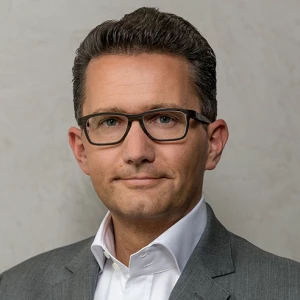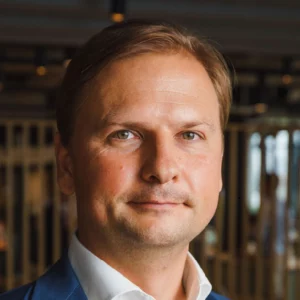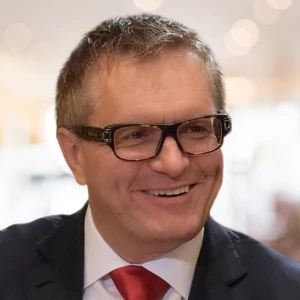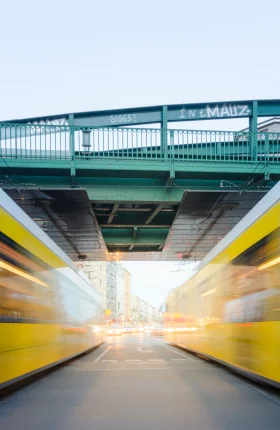Introduction
Cities around the world are at a decision point as their mobility ecosystems face unprecedented challenges. (See Exhibit 1.) Among the challenges:
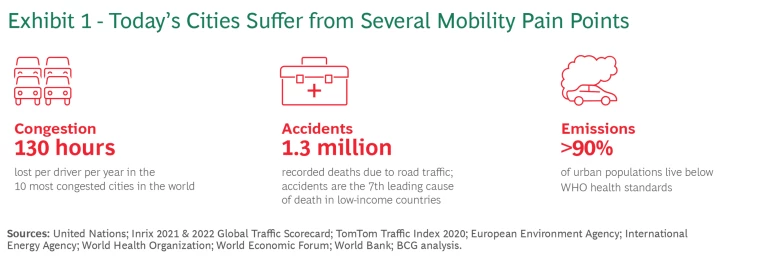
- Congestion. Drivers in the world’s ten most congested cities lose approximately 130 hours annually to traffic jams. For instance, car drivers in London experience an average travel time exceeding 37 minutes per 10 kilometers during rush hour, resulting in a loss of 148 hours per driver each
year.1 1 Inrix Global Traffic Scorecard. - Accidents. More than 1.3 million people die annually as a result of road traffic accidents. This issue is especially severe in emerging cities, such as Bangalore, where the fatality rate is approximately three times greater than in high-income
cities.2 2 Bangalore traffic police statistics. - Emissions. More than 90% of the urban population lives in conditions that do not meet WHO health standards, with car-centric cities like Riyadh regularly experiencing emissions levels more than five times above the WHO
limit.3 3 IQ Air Index.
These severe problems will be exacerbated by two trends:
- Urbanization. By 2050, a staggering 2 billion additional people will live in cities, contributing to an urbanization rate of about 70%
globally.4 4 World Cities Report, United Nations. - Automobile Proliferation. At the same time, the number of cars is expected to increase from about 1.5 billion today to about 2.4 billion by 2050, leading to additional pressure on road capacities, especially in emerging
economies.5 5 ITF Transport Outlook, International Transport Foundation.
While numerous studies have explored theoretical visions and potential projects to address these daunting challenges, many city and transport authorities are still struggling to improve the situation holistically. Instead, they focus on isolated solutions that often lack long-term and strategic planning. For example, most cities in the US have traditionally attempted to meet increases in demand by expanding the road network, leading to short-term congestion relief but long-term worsening of the situation. (In fact, the annual delay per auto commuter increased by some 270% over the last 30 years in US urban
Building on numerous urban mobility projects from the past decade, we offer practical, step-by-step guidance (“the recipe”) on how cities can shift hundreds of millions of trips from motorized private transport to public and active mobility.
The Recipe for Successful Urban Mobility Transformations
Reaching the right balance of supply and demand for a sustainable and comfortable transport system poses significant challenges and requires tailored strategies for each city. However, six elements (which correspond to our upcoming six ingredients) play a decisive role in enabling fast and enduring success (see Exhibit 2):
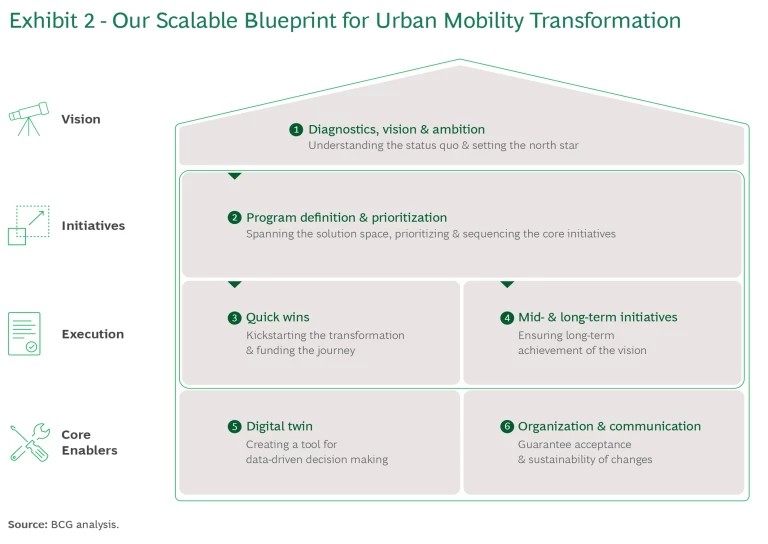
- Diagnosing the current situation and establishing a far-reaching vision and ambition
- Developing a series of initiatives across transport modes, demand levers, and (structural and political) enablers suitable to realize the vision and ambition
- Acting promptly—initiating the transformation with no-regret moves that serve as “quick wins” to fund the journey ahead
- As quick wins are implemented, laying the groundwork for more complex, high-impact projects (mid- and long-term initiatives)
- Using a digital twin to simulate the effects of various initiatives, fostering data-driven decision making
- Ensuring that the city’s organization structure can support the transformation effectively and maintaining transparent communication to gain public support
Ingredient 1: Diagnostics, Vision, and Ambition
Each city is different. With that in mind, planners must develop a deep, comprehensive, and customized understanding of urban mobility within a particular city’s borders—first diagnosing issues that impede mobility currently and then envisioning a desired and viable future state in which the challenges are overcome.
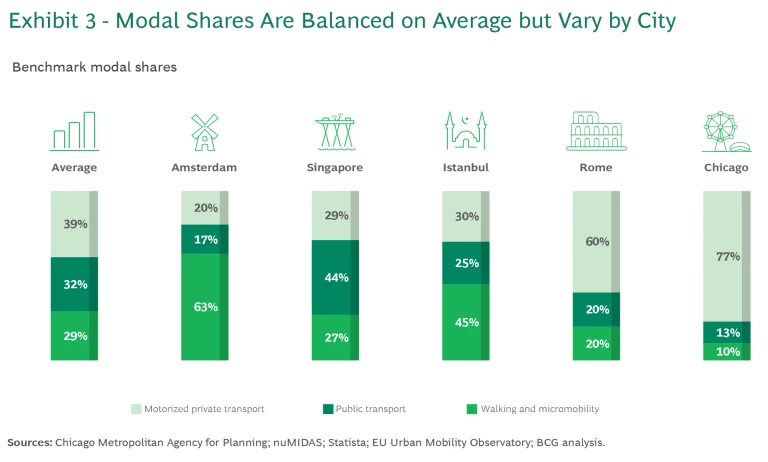
Status Quo (“As Is”). Understanding the current state and diagnosing the underlying issues in a city’s mobility system are crucial initial steps in shaping an effective urban transportation strategy. So, establishing the relative prevalence of different modes of transportation (that is, the modal share) is the cornerstone for any mobility program. Global benchmarks indicate on average a relatively even split of modes with about 39% motorized private transport, 32% public transport, and 29% micromobility and walking. (See Exhibit 3.)
However, these shares vary greatly depending on the city type and the city’s current development and transformation stage. For example, in the US, private transport often accounts for more than 70% of modal share (in Chicago, for example), whereas in many Asian cities (such as Tokyo and Singapore), public transport plays a far more critical role, with shares ranging from 47% to 53%.
Besides the modal share, key metrics such as levels of congestion, accidents, and emissions are required to set the right baseline. (See Exhibit 4.) For example, Amsterdam is a role model with respect to congestion efficiency (only 17 hours lost to congestion versus, for example, more than 100 in Rome) but could still improve on safety (approximately four deaths per 100,000 inhabitants
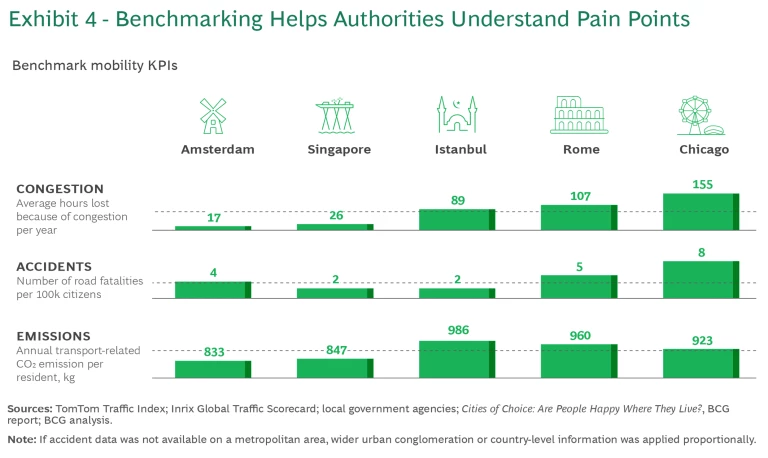
Vision and Ambition (“to Be”). To effectively address current challenges in a city’s mobility system, officials need to establish a clear vision and ambition that serve as a north star for decisions and actions. To ensure that the vision and ambition are both actionable and impactful, officials should meet essential criteria, including:
- Comprehensive Coverage of Core Mobility Dimensions. The vision and ambition must address at least three key dimensions of urban mobility—congestion, accidents, and emissions—to ensure that they touch upon the primary concerns that impact environmental sustainability and residents’ quality of life.
- Long-Term Orientation. Effective urban planning requires a long-term perspective, typically spanning five to ten years. Remember: a 5% shift in modal share usually takes more than five years to achieve.
- Financial and Practical Viability. The vision and ambition must consider financial constraints and resources. For instance, while developing a top-notch light- and heavy-rail transit (LRT/HRT) system might be ideal, alternatives like a bus rapid transit (BRT) system might be more feasible, being up to 40 times less expensive on a cost per kilometer
basis.8 8 Institute for Transportation and Development Policy.
By integrating these elements, city officials can craft a vision and an ambition that not only inspire change but also draw a practical roadmap for achieving a safer, more efficient, and sustainable urban transport system that ultimately helps to create a “ city of choice .”
Ingredient 2: Program Definition and Prioritization
Comparing the current mobility system (“as is”) with the envisioned future state (“to be”) has revealed discrepancies. Thus, a question arises: How can this gap be closed? Taking modal share as an example, this translates into a sum of initiatives suitable to enable a balanced shift between transport modes—whether that involves increasing public transport capacity or reducing private vehicle usage.
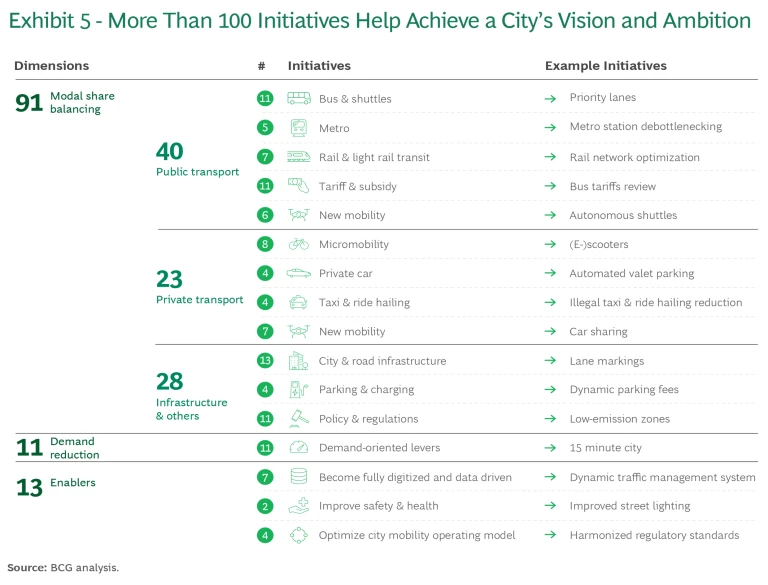
Mapping the Solution Space. BCG relies on a comprehensive list of more than a hundred potential initiatives grouped into three main categories. (See Exhibit 5.) However, not every initiative is equally impactful or suitable for every city. For example, emerging cities might need to focus on establishing basic infrastructure , like a functioning bus network, while more developed ones could explore advanced urban-planning concepts, such as “15-minute cities.” The primary task here is to refine this long list into a short list of the 15 to 20 most effective potential initiatives. This step is crucial to overall success; usually, a handful of initiatives deliver the bulk of the impact. (In a recent case, we found that 5 of 13 private transport initiatives led to more than 95% of the overall reduction in trips.)
Sequencing. In addition to evaluating the pure impact of each initiative, other factors must be considered for effective sequencing:
- Supply and Demand Balance. Maintaining a balance between “push” measures (for example, reducing private transport trips through price increases) and “pull” measures (enhancing public transport capacity and service quality) is crucial. (See Exhibit 6.) In a recent case, for instance, reducing some 25 million taxi trips per year via fare increases was offset by adding over 150 buses (each targeting more than 500 passengers per day) on major taxi routes and placing more than 1,000 e-scooters in areas typically covered by short ride hailing, thus promoting a more sustainable traffic composition.
- Time to Implementation. Certain initiatives may have long lead times, particularly those requiring legal adjustments or the construction of extensive new infrastructure.
- Cost. High-impact initiatives, especially infrastructure projects, often come with significant costs.
- Interference. Some initiatives (such as intermodal mobility hubs) may affect multiple transport modes, requiring complex simulations.
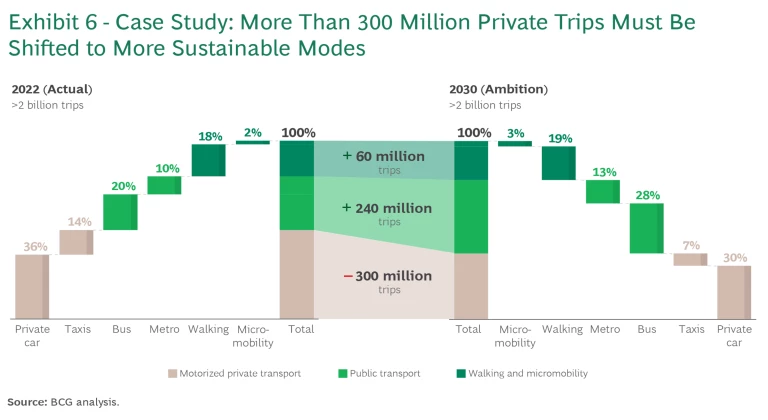
Following this comprehensive assessment, impactful initiatives can be categorized into two buckets:
- Quick Wins. These initiatives are characterized by high impact, low cost, minimal interference, and fast implementation. They are considered no-regret moves and should be prioritized for immediate action. Examples include bus priority lanes at select intersections and pop-up bike lanes.
- Mid- and Long-Term Priorities. High-impact initiatives that do not qualify as quick wins require further evaluation. This involves sophisticated, data-driven simulations using digital city twins to thoroughly understand the cost and effort versus the benefit of each initiative. High capex infrastructure projects (such as construction of bridges or bypass roads) are examples of this category.
By following these steps, cities can systematically prioritize and implement measures that effectively transform their transportation landscapes into more sustainable and efficient systems.
Ingredient 3: Quick Wins
City transformation projects can be long, complex, and costly. To secure the necessary funding and justify resource allocations throughout the project, transport authorities must quickly deliver tangible, visible results on the ground—ideally within the first six to nine months. Moreover, unsolved mobility-related issues tend to be quickly exacerbated, making it pivotal to address pressing challenges right away.
Quick wins are essential for generating early momentum and public support. These can include initiatives like establishing bus priority lanes at key intersections, implementing smarter passenger funneling at metro stations, introducing paid-parking zones, creating pop-up bike lanes, refining schedules, and reorganizing traffic flows. (See Exhibit 7.) These measures improve the efficiency and appeal of public and active transport options and demonstrate the authority’s commitment to real change.
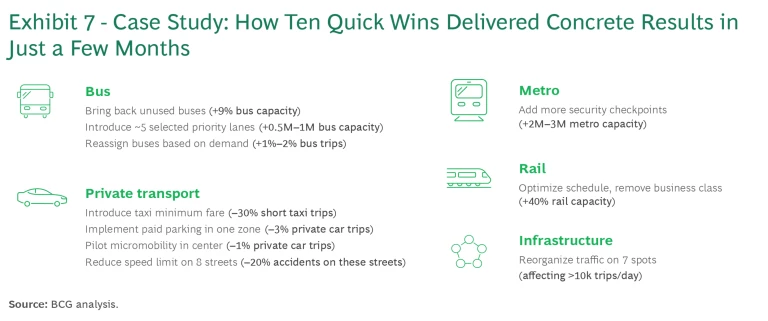
For instance, one city successfully redistributed more than 50 million trips from private to public transport and micromobility in less than a year—a 3% to 4% modal shift. This rapid progress represented about a quarter of the city’s total transformation goal. By achieving quick wins, transport authorities can build confidence among stakeholders and the public, setting a positive precedent for the more complex initiatives that will follow.
Ingredient 4: Mid- and Long-Term Initiatives
While quick wins provide immediate, visible results and help build momentum, the bulk of the transformation—typically 75% to 80% of the impact—is driven by mid- to long-term initiatives. These initiatives are central to realizing the city’s vision for its transportation system.
As the initial quick-win projects are being implemented, city officials must concurrently plan and design more complex, longer-term initiatives. These typically involve significant capex projects such as the construction of new infrastructure. Given the uncertainty of future developments (such as urbanization rates), it is vital to assess several long-term scenarios and profoundly understand their impact to ensure the most efficient capital allocation. Scenarios may include initiatives focused on developing mobility hubs, adding road capacity, or expanding metro and rail networks. Officials must also pursue analysis-intensive initiatives (such as data-driven optimization of the bus network) and projects requiring substantial legal or operational changes (for example, introducing new operating models for public transport, such as gross cost contracting for buses).
The selection and prioritization of these initiatives depend heavily on the city’s specific circumstances and the long-term goals its leaders set. While the context may vary, valuable insights can be gained by examining other cities that have successfully implemented similar transformations. For example:
- Singapore can be described as the “conqueror of congestion,” with citizens losing only 26 hours per year to traffic, thanks to measures like congestion pricing, certificates of entitlement for private car ownership, and high-quality public transport.
- Tokyo, the “world’s safest megacity,” has achieved fewer than one traffic fatality per 100,000 citizens through extensive public transit investment and pedestrian safety initiatives.
- Copenhagen is on track to become a “sustainability star” by being carbon neutral by 2025, with more than 6 kilometers of cycle paths per square kilometer—contributing to a modal share of micromobility and walking above 40%.
By learning from these precedents, city officials can better understand which initiatives might be effective and how they can be sequenced and integrated into the broader transportation plan.
Ingredient 5: Digital Twins
Traditionally, cities have relied on internal experts to conceptualize and prioritize long-term transportation initiatives. However, these experienced-based decision-making processes can fall short in comprehending the full complexity of mobility ecosystems on the ground and can be biased by individual judgments.
Enter digital twins, such as BCG’s City Flow.
Digital twins are enabled by recent advances in data-driven modeling, which now offers significantly better efficiency and effectiveness. For instance, using City Flow to reassess an infrastructure pipeline, we recently helped a client save more than $1 billion in investment while reducing travel times by over 35% in the affected areas.
Digital twins like City Flow augment urban planning, delivering insights in three ways:
- Conducting Diagnostics. Digital twins reveal actual travel patterns, identifying critical pain points that need urgent attention. They enable city officials to concentrate on the most impactful areas and go beyond the obvious. For example, BCG utilized a digital twin to pinpoint focus areas in a bus network optimization project, directing initial resources to the most crucial 20% of the network.
- Making Decisions. These tools are instrumental in defining and simulating various solutions to address specific issues, allowing city officials to gauge the potential impacts of different alternatives across a set of predefined KPIs. This process aids in making informed decisions. For instance, through simulations, we identified the optimal distribution of new metro stations, achieving a travel time reduction of over 50% for the targeted metro line.
- Monitoring Continuously. A digital twin also facilitates the ongoing monitoring of KPIs during and after initiative implementation. As circumstances evolve—because of population growth, changes in transport modes, or other factors—this continuous monitoring allows for the real-time reassessment of strategies and adjustments as needed. In a recent project, we implemented a dashboard with 15 KPIs to monitor infrastructure measures effectively.
Ingredient 6: Organization and Communication
For any city aiming to transform its transportation system, two more enablers—organization structure and effective communication—are crucial for success.
Organization Structure. A robust organization structure is essential to support the new era of data-driven decision making. This involves establishing a technology excellence department, as evidenced by successful examples in our previous work. Such a department is pivotal not only for managing the digital twin but also for tracking the success of initiatives and making adjustments based on the latest data, such as changing demand patterns. For instance, London revisits approximately 20% of its bus network annually to adapt to shifts in passenger behavior, illustrating the dynamic approach needed to keep transportation services responsive and efficient.
The organization’s (re-)structuring should also include the centralization of ownership and management of mobility assets. Diffusion of responsibility, budgets, and initiatives is among the primary reasons for delays and inefficiencies in mobility transformation programs. Combining the assets within one department or setting up a powerful decision council to align all stakeholders is a key enabler for success.
Communication. Putting citizens at the center of the change process is vital. Transparent communication of planned mobility initiatives is key to building public trust and acceptance. Taking a cue from Singapore, where the transport authority consistently explains its actions, helps everyone understand the purpose behind changes, reinforcing community support. This quote from a Singapore LTA official highlights the philosophy:
“We keep explaining to our citizens for years now why we are doing what we are doing. Everyone understands it. This is core.”
Additionally, offering channels for feedback gives citizens a sense of involvement and control. For example, London’s Transport for London (TfL) publishes proposed adjustments to bus routes and planned bike lanes online, inviting public input and suggestions. It also provides avenues for lodging complaints. Such direct engagement has proven effective; within the first year of the newly established Elizabeth line, TfL processed hundreds of customer complaints, leading to a new timetable and the recruitment of a service quality lead to enhance customer satisfaction.
These examples underscore the importance of learning from best practices in organization management and community engagement to ensure the successful implementation of transportation initiatives and avoid setbacks, such as the recent micromobility bans observed in Paris. By fostering a transparent, responsive, and citizen-centered approach, cities can navigate the complexities of transformation more smoothly and sustainably.
Concluding Thoughts on Transforming Urban Mobility
Urban mobility transformations are complex “dishes” but can be awarded “Michelin stars” if done right. And while it can become busy in the kitchen at times, a few rules should never be forgotten:
- Maintain the Balance. Successfully transforming a city’s mobility ecosystem necessitates a comprehensive approach, involving initiatives across all modes of transport. It’s crucial for city officials to ensure that any reductions in private transport are adequately compensated by shifts to more sustainable alternatives. This requires a deep understanding of the impact of each initiative and a well-planned sequence of implementation. Ensuring this balance is essential for a smooth transition and to prevent any negative impacts on the mobility network.
- Think Long Term. Transforming a city’s transportation system is a long-term endeavor. Typically, achieving a shift of approximately 5% in modal share takes about five years. There are no quick fixes; substantial changes require sustained efforts and strategic planning. Managing stakeholder expectations and engagement over such periods is critical and can be effectively addressed by demonstrating continuous progress through quick wins, as discussed in Ingredient 3. Additionally, it’s important to consider other future-related developments that might affect transportation needs, such as population growth. For example, Riyadh’s population is projected to double within the next seven to ten years, which will significantly challenge its urban mobility capacity.
- Be Data Driven. In an environment where a million citizens can generate some billion trips annually, reliance on traditional planning methods based on past experiences alone is inadequate. As highlighted in Ingredient 5, adopting a data-driven approach has proven to be a game-changer. Digital twins not only enhance the efficiency and effectiveness of transportation systems but also achieve better outcomes at a lower cost. Advanced data analytics allow for a more accurate assessment and agile adaptation to evolving urban transportation demands.
Ultimately, transforming urban mobility should be pursued not as an end in itself but as a means to build vibrant, sustainable cities—unlocking billions in value by moving millions of people. The path is challenging, but with the right vision and execution, cities can create transportation systems that are efficient, safe, and sustainable, paving the way for a brighter, more connected future for generations to come.

